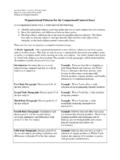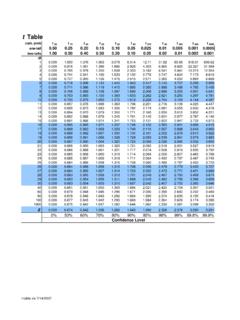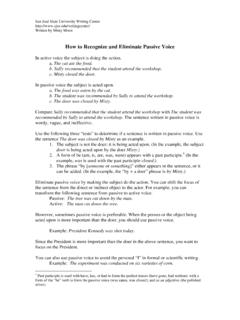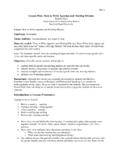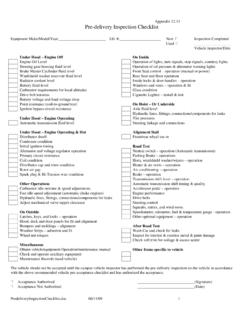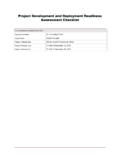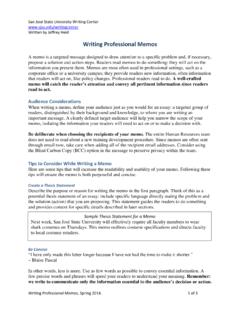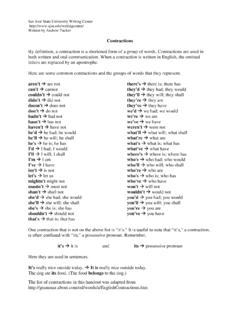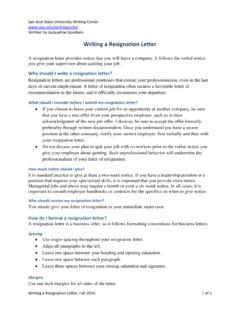Transcription of How to Write the LLD/ENGL 100A Rhetorical …
1 San Jos State University Writing Center Written by Samantha Clark How to Write the LLD/ENGL 100A Rhetorical analysis Essay, Spring 2014. 1 of 4 How to Write the LLD/ENGL 100A Rhetorical analysis Essay This handout is designed to assist you in writing your Rhetorical analysis paper. Some of the instruction given here comes from the course prompt to ensure that you meet the assignment requirements. Use the background information given here to understand the assignment. Then use the questions that follow as a supplement to the course prompt, to generate both the content and an outline for your draft. What Is a Rhetorical analysis ? The purpose of the Rhetorical analysis essay is not to summarize a piece of writing, but to explore how rhetoric works; explore how ideas are argued and presented; analyze how the strategy is working to help the writer achieve his or her purpose. What Is Rhetoric?
2 Rhetoric is the art or skill of speaking or writing formally and effectively, especially as a way to persuade or influence people. To analyze a writer s rhetoric, you need to investigate how the writer composed the writing to achieve his or her goal. The prompt outlines questions you can use to brainstorm the rhetoric of the sample you are studying. How Do I Write a Rhetorical analysis ? Take the following four steps to develop content and plan your Rhetorical analysis essay draft. 1. Analyze the Rhetorical appeals. 2. Brainstorm your introduction. 3. Develop your body paragraphs. 4. Draw a Conclusion. From the Prompt: Questions to Think about before Writing What do you think was the author s purpose in producing this writing? Who was the intended audience and how do they affect the writing? What style and tone did the author use? Why? What Rhetorical appeals did the writer use? (ethos, pathos, and logos) What logical schema were used to develop ideas?
3 (description, narration, process analysis , compare and contrast, cause and effect, etc.) How is the text organized, and why do you think the author chose this particular organizational pattern? Is there a particular format that is used? Why do you think the author included or omitted particular information? What kinds of evidence did the author include to support his/her point of view, and how was that evidence used? How to Write the LLD/ENGL 100A Rhetorical analysis Essay, Spring 2014. 2 of 4 Analyze the Rhetorical Appeals Analyzing Rhetorical appeals can seem daunting. However, you can approach this analysis as a simple matrix for outlining the contents of your paper. Definition How does the writer use each strategy to develop his or her purpose? Ethos: Ethical appeals establish the credibility and goodwill of the author or of the sources used to support an argument. Where and how does the author explain his or her related background or establish the credibility of the sources used?
4 Pathos: Emotional appeals draw on the readers emotional response to the subject and on shared beliefs and values. Where does the author use language and/or create images that are emotionally charged? Logos: Logical appeals use reasoning and evidence to support an argument. Logical appeals draw on facts, statistics, research, financial costs, observations, and experiments to reach conclusions using logical schema. Where and how does the author use evidence? What kinds of evidence are used? What logical schema does the author draw on to interpret the evidence? Brainstorm Your Introduction Once you have answered the prompt s questions and filled out the Rhetorical appeals table, you will have generated a lot of specific information for your Rhetorical analysis . You are now ready to start drafting your paper. You can begin with the introduction. In a Rhetorical analysis essay, the purpose of the introduction is to provide information about what is to come.
5 1. How do writers use Rhetorical writing to achieve their purpose? 2. Introduce the paper you are analyzing. a. Who is the writer? b. What were the circumstances under which the paper was written? c. Give the full title of the paper, indicate when it was written, and identify the intended audience. 3. What do you think was the writer s purpose? a. What did the writer want to achieve? b. What did the writer want the reader to conclude? 4. What are the Rhetorical appeals and strategies used by the author? Which appeals will you discuss in your analysis ? This is your preview statement. How to Write the LLD/ENGL 100A Rhetorical analysis Essay, Spring 2014. 3 of 4 5. What is your central argument? How did the writer use the Rhetorical strategies and appeals to accomplish his or her purpose? Was the writer successful? The answers to these questions can be summarized as a thesis statement. From this example, can you identify which Rhetorical strategies and appeals the student will likely discuss?
6 Develop Your Body Paragraphs Make sure to analyze instead of summarize your chosen piece of writing. Each paragraph in the body should have its own topic sentence and a unified focus. You should Write one paragraph on each of the Rhetorical strategies and appeals that you mention in the introduction. Draw a Conclusion In the conclusion to your Rhetorical analysis essay, summarize briefly the main points of your analysis to explain its significance and to draw a clear and specific conclusion. Rhetorical analysis Thesis Statement Example The author s emphasis on her first-hand experience as a mother who lost her son to E. coli and use of evidence that is descriptive and data-driven make her argument about FDA policy reform persuasive. Questions to Consider for Your Outline You can use the following questions as you begin to outline your paper. What is the definition of the Rhetorical strategy or appeal you are writing about?
7 What is your evaluation of the writer s use of that Rhetorical strategy or appeal in regard to his or her purpose? How do two to three examples from the paper illustrate the use of that strategy or appeal? How do the examples contribute to the writer s purpose? How does the strategy or appeal contribute to the writer s purpose? Questions to Consider for Your Conclusion conclusions can you draw about the role in general of Rhetorical appeals and strategies in producing clear communication through writing? the author successful in using the various Rhetorical appeals and strategies for the intended audience and purpose? changes might you recommend to the author to better achieve his/her purpose? does this assignment help improve your writing, help your critical thinking skills, and help you become a better reader? lessons have you learned by writing a Rhetorical analysis ? How to Write the LLD/ENGL 100A Rhetorical analysis Essay, Spring 2014.
8 4 of 4 How Do I Edit My Draft? When editing your writing, consider how your writing looks to someone else. What is clear to you may not be clear to others. You are writing for someone who is unfamiliar with your topic, and your instructor is evaluating you on your understanding of the Rhetorical strategies and appeals as well as the clear presentation of your analysis . As you work through the following editing worksheet, assume the role of your intended audience: 100A instructors and the portfolio committee. Editing Worksheet Thesis Statement 1. Does the thesis statement provide an evaluation of the sample text? 2. Does the thesis statement provide reasoning behind that idea? Content 1. Does the draft explain why each strategy was important to the audience of the text and explain how the strategy is working to help the writer achieve his or her purpose? Does the draft do more than summarize the article?
9 2. Do any of the claims remain vague? Where might the 100A audience need more illustration, evidence, or discussion of evidence to follow the conclusions drawn? Structure 1. Does the paper provide cues at each paragraph opening and closing to help the reader follow the reasoning of the paper? 2. Does each paragraph have a clear central idea? Is evidence tied to a clear conclusion at the end of the paragraph? 3. Does the conclusion briefly summarize your main points and explain the significance of your analysis ? References Lunsford, Andrea A. The Everyday Writer. 5th ed. Boston: Bedford / St. Martin s, 2013. Print.
